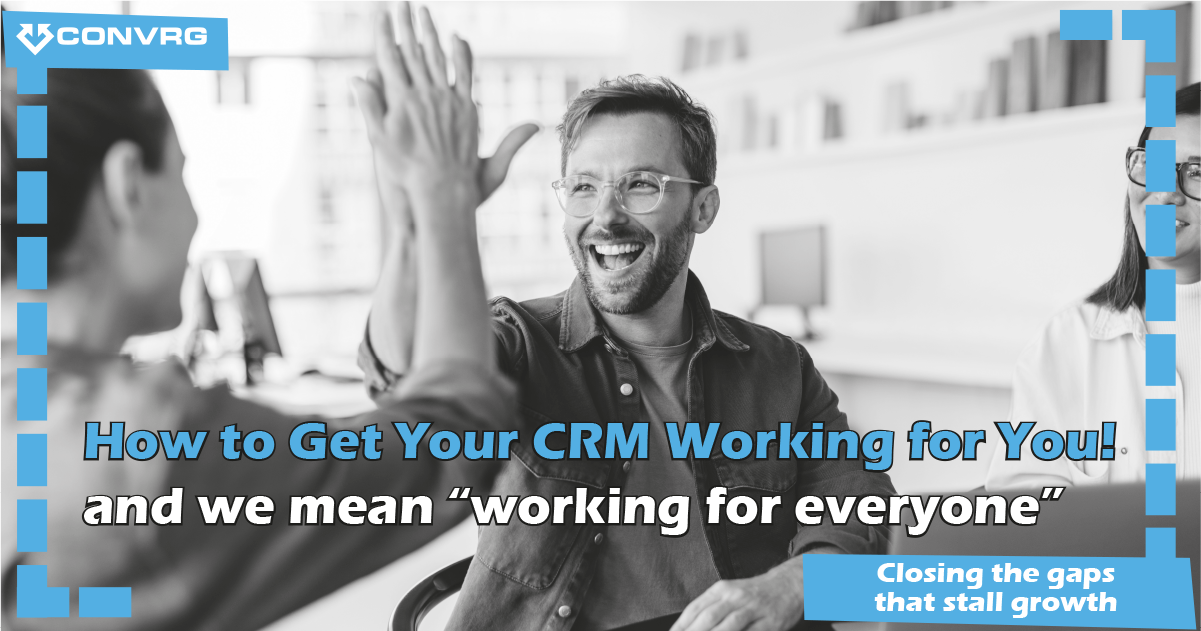Introduction: Why Your CRM Isn’t Working for You (Yet)
CRM systems have become integral to modern businesses. From sales teams tracking leads to customer service teams improving satisfaction, a well-implemented CRM can streamline operations and offer valuable insights into customer behaviour. However, many businesses still struggle to unlock the full potential of their CRM system.
You might be experiencing frustrations where your CRM feels more like a burden than an asset. It's frustrating when the data is disjointed, workflows are inefficient, or your team simply isn't engaging with the tool. But, before you blame the system itself, ask yourself: Is your CRM being used the way it should be?
The first step to getting your CRM working for you is to identify what’s actually wrong. Often, the issues aren’t with the tool itself but with how it’s been set up, adopted, and integrated into your business processes. It’s time to fthat. The first step? A CRM tune-up.
The Common CRM Pitfalls: What’s Really Going Wrong?
It’s not uncommon for businesses to fall into some of these common CRM pitfalls. Let's dive deeper into each issue and explore how they impact the overall performance of your CRM system.
- Lack of Alignment with Business Processes
Many companies implement a CRM with the belief that simply using the tool will automatically make everything run smoothly. However, CRM systems often fail to deliver when they aren’t properly aligned with existing business processes.
For example, if your sales team uses the CRM for tracking deals, but your customer service team doesn’t have visibility into that data, you’re operating in silos. These silos cause duplication of effort, inconsistent customer experiences, and data fragmentation.
Real-world example: A manufacturing company in the Midlands used a CRM that wasn’t properly aligned with their production and logistics teams. As a result, they had an incomplete view of customer orders, which led to delays, customer dissatisfaction, and missed opportunities. Once their CRM was aligned with these internal processes, the business saw a dramatic reduction in customer complaints and better operational efficiency.
- Absence of Leadership Engagement
CRM adoption isn’t just an IT or operations issue. It’s a leadership issue. Leadership teams that don’t actively engage with CRM implementation risk a fragmented approach. When leadership isn’t aligned, neither is the organisation.
When a company’s leadership is actively involved in the CRM strategy - from selection and implementation to adoption - it sets the tone for the entire organisation. This involvement ensures that the CRM is not just a tool but a part of the broader business strategy.
Real-world example: A software company in London faced challenges with CRM adoption across teams. The leadership had not defined clear expectations for CRM usage, so employees didn’t take it seriously. Once the CEO became involved and set clear expectations for CRM engagement, the entire team started using the system more effectively. They quickly realised the CRM could drive revenue by providing real-time data on customer behaviour and sales progress.
- Poor Data Quality
A CRM system is only as good as the data entered into it. If your CRM contains inaccurate, incomplete, or outdated information, it will fail to provide meaningful insights. Without clean data, any decisions made based on the CRM will be flawed, leading to missed opportunities and incorrect strategies.
Maintaining high-quality data is crucial to the success of any CRM system. This means ensuring data is regularly updated, duplicates are removed, and errors are corrected as soon as they are detected.
Real-world example: A hospitality business had multiple branches that were all feeding customer information into the same CRM system. Due to poor data entry practices, the CRM became filled with duplicates, incorrect contact details, and outdated information. The business had difficulty running marketing campaigns or understanding customer preferences because of this bad data. After implementing a data hygiene strategy, they cleared up the CRM and started targeting the right customers with more effective campaigns.
- Employee Disengagement
Your CRM will never work unless your team uses it. Employee disengagement is a common problem, especially if staff members don’t see the value in using the CRM system. Often, this disengagement stems from poor training or insufficient support during the adoption phase.
Real-world example: A law firm implemented a CRM, but many employees found it difficult to use. As a result, they avoided using it altogether. With limited support and training, staff members couldn’t see the CRM’s benefits, which led to low engagement. After a CRM tune-up that included training and integration into daily workflows, the firm saw a significant increase in CRM usage, which translated into higher client retention rates.
The First Step: A CRM Tune-Up
Now that we’ve identified the potential issues, let’s focus on how to get your CRM back on track. A CRM tune-up involves a thorough evaluation of your system to ensure it’s working optimally for your business.
- Data Health Check
Start by conducting a deep data health check. Poor data is one of the biggest barriers to CRM effectiveness, so this step is critical. Clean your data by removing duplicates, verifying customer contact details, and ensuring accurate segmentation.
Practical Tips:
- Implement automatic data validation checks during CRM data entry to ensure accuracy.
- Set up regular data reviews to prevent future issues.
- Standardise data entry to maintain consistency (e.g., use consistent naming conventions).
- Streamlining Workflows
Next, review your CRM workflows. Are they designed for efficiency? Are there unnecessary steps or redundant processes that can be removed? Optimising workflows is crucial to getting the most out of your CRM.
A tuned-up CRM should make your team’s job easier, not harder. If it’s overly complicated or doesn’t fit with your current processes, then it’s time to streamline.
Practical Tips:
- Automate repetitive tasks (like follow-up emails or notifications).
- Ensure your CRM integrates with other business tools (e.g., email, calendar, invoicing).
- Align workflows with business objectives to maximise efficiency.
- User Experience Optimisation
User adoption hinges on user experience. If your CRM isn’t intuitive or doesn’t align with your team’s way of working, engagement will suffer. Take the time to customise the CRM interface to make it easier for your team to navigate and use regularly.
Practical Tips:
- Simplify navigation by customising dashboards.
- Ensure the system is mobile-friendly for remote workers.
- Provide accessible support and resources for your team to turn to when needed.
How CRM Tune-Ups Lead to Closing the Gap
Once your CRM is tuned-up, the next step is to close the Adoption Gap. The Adoption Gap is the distance between what your CRM should be doing and what it’s actually doing. After a CRM tune-up, the gap will be smaller, but you can’t stop there.
It’s important to assess whether your CRM system is fully aligned with your business strategy. Even after tuning up the CRM system itself, you still need to address the broader strategic issues.
The Benefits of a Properly Tuned CRM System
By conducting a CRM tune-up, businesses can expect several benefits, including:
- Improved Data Quality
Clean data helps teams make better decisions and reduces errors in sales and marketing efforts. - Increased User Engagement
A system that works for your team leads to higher adoption, which in turn leads to better results across the board. - Optimised Business Operations
Streamlined workflows reduce the time your team spends on administrative tasks and improve overall efficiency.
The Next Step: Introducing the SIMPLIFI Framework
Once your CRM is tuned-up, you’re ready for the next step: aligning it with your broader business strategy. This is where the SIMPLIFI Framework comes in. The SIMPLIFI Framework is designed to help businesses scale by aligning strategy, systems, teams, and execution.
SIMPLIFI will help you build a CRM strategy that is integrated with your business processes, ensuring that CRM is a core part of your overall business strategy, rather than a separate tool that’s difficult to integrate.
Conclusion: Take the First Step Today
Your CRM can be one of the most powerful tools at your disposal - but only if it’s working for you. A CRM tune-up can transform an underperforming system into an asset that delivers better data, streamlines workflows, and boosts team engagement.
Book a CRM tune-up today and take the first step towards closing the Adoption Gap in your business.




.jpg)

